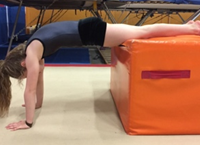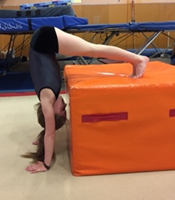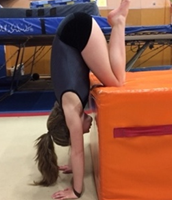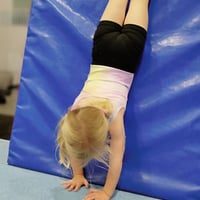Handstand Hacks: Perfect Your Form with These Pro Tips and Coach Insights
Master Your Handstand with Perfect Alignment
Handstands are one of the most iconic and impressive skills in gymnastics. Whether you're a beginner or a seasoned athlete, mastering the handstand is a crucial milestone on your gymnastics journey. But while handstands may look effortless, they require strength, control, and proper technique to execute correctly.
One key factor that often gets overlooked in the pursuit of a solid handstand is alignment. A properly aligned handstand not only helps improve your balance and control but also reduces the risk of injury. In this post, we'll break down how you can master your handstand by focusing on two essential elements: engaging your shoulders and keeping your body straight.
But don’t forget—having the right coach and the supportive environment of a Olympia Gymnastics class is just as crucial in helping you reach that perfect handstand. With guidance and constructive feedback from awesome coaches, you’ll develop the proper technique and confidence to take your handstand to the next level.
1. Engage Your Shoulders
One of the most common mistakes when learning handstands is not fully engaging the shoulders. If your shoulders aren’t active, you’ll find yourself collapsing or over-arching in your lower back, which can throw off your balance and even lead to injury.
How to engage your shoulders:
- Start by pushing the ground away from you with your hands. This is often referred to as “pushing through your shoulders” or creating a “scapular depression.”
- Imagine trying to reach the floor with the heels of your hands while keeping your elbows slightly locked.
- Your shoulders should be protracted (pushed outward) and elevated (pushed toward your ears), which will help stabilize your upper body and create a solid base for your handstand.
A great gymnastics coach will be able to identify whether your shoulders are correctly engaged. They’ll also help you with specific drills to strengthen your shoulder muscles and improve mobility, making it easier for you to keep those shoulders active and stable during the handstand.
2. Keep Your Body Straight
Another key to a strong handstand is maintaining a straight body line. A common mistake is arching your back, which can throw you off balance and make it harder to stay inverted. To perfect your handstand, you want to create a straight line from your wrists all the way through your feet.
How to keep your body straight:
- Focus on keeping your legs together and your toes pointed.
- Squeeze your glutes and tighten your core to help maintain that straight line from head to toe.
- Think of your body as a “one piece” – everything should stay aligned and engaged, from your fingertips to your toes.
Coaches play a huge role in helping you develop body awareness. They’ll correct any misalignment, offer cues like “tighten your core” or “point your toes,” and give you personalized feedback on how to improve your form. Plus, they can spot any muscle weaknesses that may be preventing you from maintaining a straight body line and can prescribe targeted exercises to build those areas.
3. Practice Against a Wall
If you're struggling to find balance in the handstand, practicing against a wall can provide the support you need while you focus on technique. While the wall will help you stay upright, it’s crucial that you don’t rely on it as a crutch. Instead, use the wall to help build confidence in your alignment and strength.
How to use the wall:
- Start by facing the wall and kicking up into a handstand so that your feet gently touch the wall for support.
- Work on squeezing your legs together and pressing your heels toward the wall to encourage alignment.
- As you build strength and control, gradually reduce the amount of time you spend against the wall until you can hold the handstand independently.
Coaches can give you guidance while you're practicing wall handstands, ensuring that you’re positioning your body correctly and getting the most out of your practice. They’ll also be able to spot when you need to make adjustments to your posture or technique and provide immediate feedback to keep you on track.
4. Focus on Small Progressions
Mastering the handstand takes time, and it’s important to break the skill down into smaller progressions. Start with basic drills that will build shoulder strength, core stability, and body awareness.
Handstand Progressions:
- Wall Walks: Walk your feet up a wall while keeping your hands in front of you. This will help you build strength in your shoulders and practice aligning your body.
- Handstand Holds: Start in a wall handstand position and hold it for a set amount of time, focusing on pushing through your shoulders and keeping your body straight.
- Kick-ups: Practice kicking up into a handstand and finding balance, using the wall for support at first if needed.
Experienced coaches know exactly where to start and how to progress you through the different stages of handstand development. Whether you're learning to kick up, hold the handstand, or balance without a wall, your coach will help you break the skill into manageable steps and provide structured progressions to build your confidence and strength.
5. Be Patient and Consistent
Remember that handstands don’t happen overnight. It takes consistent practice, strength-building, and focus on form to make real progress. Celebrate small victories along the way, whether it’s holding your handstand for a few seconds or maintaining perfect alignment for just a moment longer.
Coaches are there to motivate you through the process and remind you that progress takes time. They’ll celebrate your milestones with you and encourage you to stay patient. With a coach’s support, you’ll feel more confident in your ability to keep improving and perfecting your handstand.
Handstands are a combination of strength, balance, and technique. By focusing on shoulder engagement, body alignment, and practicing with purpose, you’ll be well on your way to mastering the handstand. But even with all the right drills, the guidance of a skilled coach and the supportive environment of a gymnastics class is crucial for accelerating your progress.
Coaches not only provide valuable feedback and corrections but also help you stay motivated, build strength, and push through challenges. With their expertise and your dedication, you’ll soon find yourself holding a beautiful, perfectly aligned handstand—strong, stable, and confident.
So, the next time you kick up into a handstand, remember: engage those shoulders, keep that body straight, and practice, practice, practice! And don’t forget, your coach is there to guide you every step of the way! ??♀️






